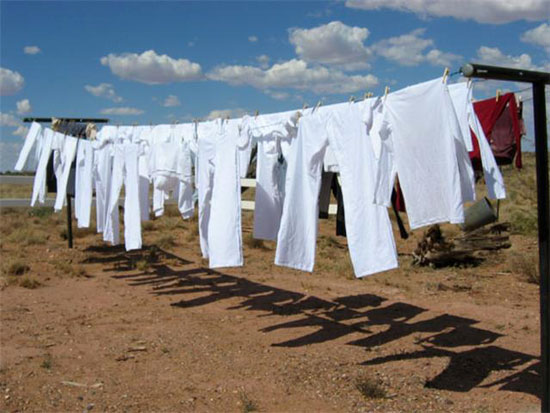
Some of you know that one of my biggest challenges due to environmental illness (EI) has been finding tolerable clothing. Many people with chemical sensitivities have great difficulty getting new clothes tolerable due to all the chemicals and dyes used in modern clothing manufacturing processes. Even organic cotton, wool, linen, bamboo, and hemp materials can cause problems for many with chemical intolerances, because we can become sensitized to the natural plant oils. To add to the problem, many of us do not tolerate laundry detergents and cannot clean our clothes even if we are able to get them tolerable enough to wear.
Around two years ago after a pesticide exposure in Florida, my challenges with clothing became insurmountable and I found myself sitting naked in my apartment for a week. I wrapped myself in an old shawl to do laundry outside and was able to get one outfit tolerable enough so that I could attend a week at the Hippocrates Health Institute. I spent 5 days drinking vitamin and mineral rich green vegetable juices and eating salad. The nutritional infusion was enough to boost my health so that I could drive across country to Arizona in search of safe housing. I made the 4-day trip wearing my bathing suit and shawl!
What I have been forced to wear due to my severe intolerance of standard clothing materials. The shirt on the left was turned upside down and used as pants when I no longer tolerated any of my sweatpants or leggings last winter. I tied the arms up as they shredded from use, to create a “socks” effect. What you can’t see is that it is riddled with small holes and is quite thin. The underwear is ridiculous but I needed something to use during my menstrual cycle to hold my sanitary napkin in place. I’m not proud to display these, but I think it is important to raise awareness at how desperate the situation is for some of us.
After I arrived in Arizona, I was unable to wear any of the clothes I had brought with me. A local friend donated several shirts and pairs of pants to me that I was able to wear because she had spent a long time washing and offgassing them. I wore those clothes for 2 years straight without ever washing them, until they literally fell off my body in shreds. Lucky for me, by this time I had discovered a procedure for washing my clothes that worked! It’s laborious and my electric bill is suffering greatly, but I finally have some clothes to wear.
Here’s what I do:
• When I receive new clothes in the mail, I turn them inside out (to avoid discoloration and fading from sun exposure) and place them outside on the clothesline for several days or even weeks, making sure to bring them inside before it rains or if there are heavy airborne exposures like controlled burns or fabric softener fumes from neighbors.
• Then I boil like clothes (all organic, or all whites, etc.) in a stainless steel stockpot on a commercial hotplate outside my home for about 5 hours. Do not attempt to boil clothes indoors, as all the toxic chemicals and/or plant oils will be released into your safe home environment. I use a drop of Allen’s Naturally detergent which I do not necessarily tolerate, but it rinses out completely. I also add several handfuls of sea salt once the water is boiling. Be careful, as the sea salt can discolor and stain your clothing – best to push the clothes aside with a stainless steel tong as you dump the salt in and swirl it around so that it dissolves and does not sit in a clump on your clothes.
• I then wash the boiled clothes in my washing machine with Allen’s Naturally detergent for one full wash cycle with an extra rinse, then send through the wash and extra rinse cycle again, but this time without any detergent – just water. I do this to make sure all the Allen’s detergent is rinsed out of my clothing. You can use whatever detergent you tolerate. Some people prefer organic soap nuts rather than a detergent. Depending on your sensitivities, you may not need to rinse them as well as I do, or you might require more of a rinse.
• I air dry them overnight on my beloved stainless steel collapsible drying rack. Personally, I have found I tolerate my clothes better when I dry them inside my home rather than in the outdoor air, which can contaminate them with pollutants like wood smoke, neighbors’ laundry products, or even local plant fragrances. You might experiment to see what works best for you.
• I usually cannot tolerate my clothing after this first cycle of boiling and washing, so I then have to repeat the whole process, but this time boiling only 1-3 hours. This process has enabled me to get several shirts and pants tolerable, as well as a light blanket. I can even now tolerate some organic cotton pieces, which I could not before.
I’m not sure why the sea salt is necessary, but two people with severe reactivity to fabrics recommended it to me. If I had to guess, I would say it helps draw out the chemicals, and kills any bad bacteria. I have also wondered if it affects the electrostatic qualities of the clothing because one of the people who recommended it was severely EMF sensitive like myself. If anyone knows why sea salt helps the process, please let me know in the comments section below.
Here are links to all the resources I use. You might find better prices or slightly different products that will give you similar results:
Nemco Single Burner Stainless Steel Commercial Hotplate – 2000 watts, 240 volt (this link is to the double burner; call the company and ask for the single burner unit) <$200 (plus shipping) from Katom Restaurant Supply Stainless steel stockpots – purchase pots as large as your hotplate can handle so you can fit ample pieces of clothing in them.
Allen’s Naturally Biodegradable Liquid Laundry Detergent <$12 from NEEDs Celtic Sea Salt – 5 lb bag $22.50 + shipping from Selina Naturally
240 volt outlet box – I paid ~$50 to have a special outlet installed by a local electrician outside my home near my electric panel; your price might vary depending on how far the electrician has to travel. Make sure the outlet fits your plug, as 240 volts can have different configurations.
Drying Rack – I purchased my stainless steel drying rack from Stacks and Stacks many years ago. They don’t seem to make it anymore but there are similar styles available on Amazon.com. I chose a more expensive stainless steel version rather than wood to avoid mold and warping.
These are the clothes that have worked for me so far:
American Apparel – supposedly clothing made by this company does not have the toxic sizing/finishes that clothing made in China does, and it’s made in the US which greatly reduces the chance that it’s been sprayed with insecticide. Plus, I’ve been told that they use cotton piping in their cotton pieces instead of polyester serging. I have had luck with their non-organic cotton, but they also do sell some organic pieces.
#RSA6321 Sheer Jersey Long Sleeve Henley Dress – 100% sheer jersey cotton
#6307 Sheer Jersey Long Sleeve T – 100% sheer jersey cotton
#5450 California Fleece Slim Fit Pant – 100% cotton (except for Heather Grey)
#5375 California Fleece Straight Leg Pant – 100% cotton (except for Heather Grey)
#8375 Cotton Spandex Jersey Straight Leg Yoga Pant – 95% Cotton / 5% Elastane (Heather Grey contains 10% Polyester)
Patagonia – Women’s Serenity Tights 85% organic cotton/15% spandex knit
Hanes – Men’s Boxer Briefs They no longer carry this item but you might have luck with other 100% cotton styles. My first pair was donated by a neighbor, and since I tolerated them I kept buying them. They might also sell women’s underwear that works for you. Keep in mind that sometimes the materials used changes so you should look carefully at those listed on the website before ordering.
Jockey – Seamless Cotton No Wire Bra
These clothing items and this washing process might not work for everyone. And there may be other less expensive and laborious ways of washing clothes that are better suited for you. This is what worked for me and I am sharing it with the hopes it can help someone else who is stuck without clothing or with clothing that is dirty and tattered.
Below are some soaking techniques others have shared with me over the years. Make sure you have a tolerable tub or basin to soak your clothing in. I use stainless steel warming trays I bought from a restaurant supply store.
Baking soda or borax soak
Soak laundry in a baking soda or borax bath overnight using about 1 cup of product per load to remove odors. Follow with your favorite well-tolerated detergent. Rinse well. If using a machine, send through the rinse cycle twice.
Milk soak
The fat in milk is said to absorb chemicals. Immerse your laundry in whole milk and place in a covered pot in the refrigerator to avoid souring the milk. Let it sit for 24 to 48 hours and then rinse well. Follow with a baking soda or vinegar bath to remove the milk smell from laundry. Follow that with your favorite well-tolerated detergent. Rinse well. Many have used powdered milk with good results.
Vinegar soak
Soak laundry in a distilled white vinegar bath overnight to remove odors. Use about 1 cup vinegar per load. Make sure you use a grain-based vinegar – Heinz used to be grain-based but may now use a GMO corn-base. Follow the vinegar bath with baking soda to remove the smell if you wish, and then your favorite well-tolerated detergent. Rinse well. If using a machine, send through the rinse cycle twice.
Tolerable detergent soak
Some people have luck soaking clothing for two weeks or even a month in a tolerable detergent, changing the water if it gets mold or too stinky.
Sun soak
Combine any of the other soaks with some natural solar heat: after washing, dry your clothes outdoors if you have access to clean air and the hot sun. The sun’s rays can bake odors (and mold!) out of clothing. You may have to leave your laundry outdoors two weeks, or longer. Make sure there are no fabric softeners, burning wood, pesticide sprayings or other harmful toxins in the air from neighbors; they could re-contaminate your clothing.
Plain water wash
Not recommended. I used to wash my clothes in plain water and then at one point could not tolerate any of them. Others suggested that the water alone cannot remove body oils, candida, offgassing chemicals, etc. and that I needed to use a detergent if I wanted to keep my clothes clean.
What if you have to use a public laundromat?
When I first became chemically sensitive, I was using public laundromats in New York City – can you imagine!? I don’t recommend it!! There are some of you who must use a public laundromat, and here are my tips for how to minimize exposures and clothes contamination there:
• Wash your clothes during off hours when the least amount of people are using the laundromat – ask the owners for the best times. The earlier the better, before the machines have built up chemicals from being used all day.
• Run one or more cycles with a tolerable vinegar (and no clothing) to clean the machine out as best as possible before putting your clothing in.
• When transferring your wet clothes from washer to dryer, put them in a plastic bag and transfer them as quickly as possible to avoid contamination with whatever chemicals are airborne. I contaminated an entire wardrobe by not following this advice.
• Or, avoid the dryer altogether and bring your clothes home to hang dry immediately. If fabric softener has been used in a dryer, there will always residue that can potentially contaminate all your clothing. The chance of this is pretty high in a public laundromat.
Tools for handwashing clothes
If you live in a city your best option may be to handwash your clothing, since many landlords will not allow washing machines to be hooked up in rental units. Here are some resources for making the process easier. I cannot vouch as to whether or not they would be tolerable for people with environmental sensitivities. Please do your due diligence and research materials before buying any product:
Galvanized Wash Tubs
Lehman’s Own Washboards
Rapid Washer
Galvanized Double Rinse Tubs
Lehman’s Hand Washer
WonderWash Mini Clothes Washer
Lehman’s Best Hand Wringer
Dyna Jet Hand Wringer
I would also like to add, that water quality is a big issue to figure out if you are challenged by clothing. When troubleshooting, keep in mind that sometimes the water you are washing the clothes in is actually the culprit. Please see these links for more on water purity: Pure Air and Water | Water Filters | Dr. William J. Rea on Best Water Source. If you are chemically sensitive and have additional tools, products, or techniques for washing clothing that you’d like to share, please post them in the comments section below.


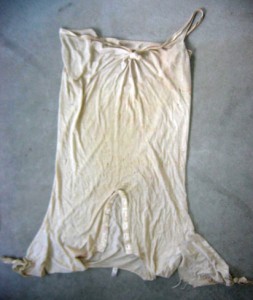
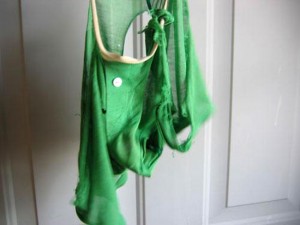
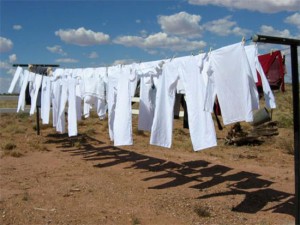
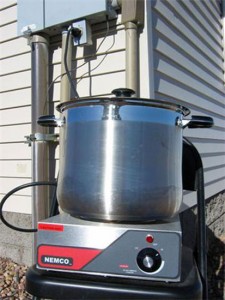
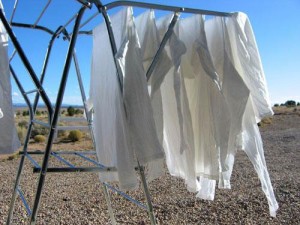
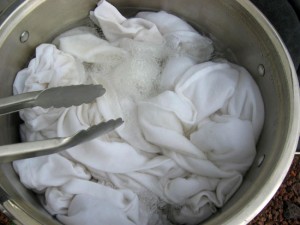

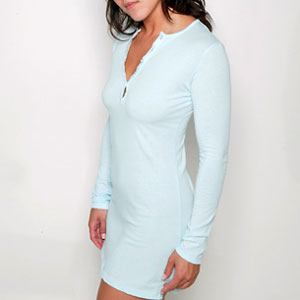






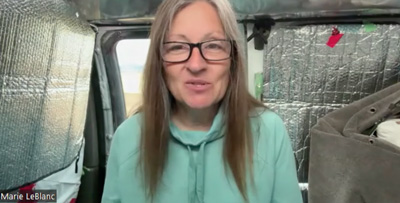


When wet and drying, clothing seems very absorbent of whatever is in the air around it … and this material can become embedded deeply inside of the clothing.
Very true Erik, this is why I dry mine indoors. My clothes pick up the scent of local plants if I dry them outdoors, and of course, anything else that might be in the air like wood smoke or car exhaust.
thank you so much for posting julie- so glad you found this way that worked for you. Since living at my parents, I tried the public laundry room downstairs without running vinegar through – it was terrible. I put two sweatpants though and had to throw it away! I think I picked a very bad machine.When I get back (I am away for a week) will run vinegar through like you say- someone else told me to do that. For now, I have the wonder washer, which looks like a blender for clothing and use allens too. I then hang it on a laundry stand. I will also put it right in bag as you say. I am actually going to write a letter to the co-op board about having a non scented machine (there is only one percent chance) but I am going to go for it. In two weeks I will try the vinegar and tell you if it works!
Julie, Way to go. Thanks for writing this up. I’m so glad you have found something that works–however labor intensive it is!
One thing to note for people who are extremely sensitive to molds is not to let your clothes soak for more than 24 hours–and make sure they have enough water covering them. I just soak them, then take them out to hang dry, soak again, and then wash. Just don’t leave them in too long or they can get irreparably ‘musty’ smelling.
Take good care!
Chris
if you have mold in your washer buy something called “smelly washer” it is a powder of enzymes that kills molds- work
Hello Julie
Have you tried these?
http://www.aehf.com/catalog/index.php?cPath=32_161&osCsid=329b204262857a4bd0e44fe6c31916a5
They worked for me.
Regards!
I love all of your effort and hard work to write this article. Well done.
Question: Do you find that you have to buy your clothing larger in size in order to allow room for shrinkage due to the boiling?
I have to soak my clothing in milk.
Then a day in vinegar.
Then a day in baking soda.
Then a day in Hydro peroxide and GSE.
Then I repeat.
Then I hang on the line inside out for 2 to 3 days.
Then I repeat.
Then I hang for a day.
Then I wash 30 to 36 times. I used to have an ozone machine. I used to run 3 loads at a time.
One would be ozoning the length of a wash cycle in a covered rubber garbage tub offgassed well.
Another load would be in the washer.
Another load would be in the dryer.
I have a washer and dryer hooked up outside on a pad in my yard for toxic items.
I have another washer and dryer in the laundry room that is built off my indoor house for better offgassed clothing.
The ozoning helps a lot, but I need someone to handle that part of the equation.
Shrinkage?
Hugs to you, Raven
I don’t buy them any larger because I am boiling. I already buy large and x-large on some of them. I don’t notice shrinkage at all. But your experience might vary depending on the clothing material you use. Wow, Raven, you sure have to go through a lot to get clothes manageable. Hearing everyone’s struggles with laundry is making me feel real lucky I don’t have it worse. Glad we can share all our tips and experiences with each other!!
Julie this article ROCKS ! Just like you out there in the desert writing masterly stuff that helps all of us. You just saved me so much anguish and time via whatever efforts you must have had to expend to get this out of your brained wiring and into our hands. Kisses for saving my energy, in so many ways, with yours. Tekaye
Thank you Tekaye, so glad you enjoyed the article!! xx Julie
Have you heard of he following: ?
I can wear brand new clothes……As soon as they are cleaned (laundered or dry cleaned) even in fresh/detergent free water they become intolerable.
Could my diet be an additional factor?
This is ruining my life, and i don’t know how much more I can take.
It seems someone finally understands…
Julie,
Thank you for this great article.
What size stainless steel stock pot do you use? 12 quarts?
My method of soaking clothes in baking soda and then vinegar and then baking soda again and then vinegar again, etc. — takes many, many days. Your process sounds quicker!
-Sue
Julie,
A second question — can you boil underpants with elastic waist-bands (I buy Jockey 100% cotton) and fitted sheets with their elastic?
-Sue
Julie,
Would boiled jeans shrink and become unwearable?
-Sue
Hi Sue,
My stainless steel pot is 20 quarts and is quite heavy when filled with clothes and water and hard to carry. I just got a rolling cart to help me with that. I usually don’t fill it to the top though – it needs room to boil without overflowing. By the way, the water often overflows over the top of the pot onto the hotplate below so its good to keep an eye on it throughout the process and turn the heat down if you need to lower the boil.
I have boiled Hanes underwear with elastic waistbands, and Jockey bras with elastic and both have been fine. I have not tried fitted sheets and was concerned about that too. I was thinking of just doing the flat sheets. I have not boiled jeans but I am not worried about them shrinking. In my experience, the shrinking of jeans happens in the dryer. I don’t have dryer. I just air dry in my home. Hope this helps!
Hi Earthwalker,
Your story has had many effects on me. I felt for the first time that I was not alone in this crazy condition. I became CS to clothes twenty years ago. I have mostly washed them over and over, some become wearable some not. I live in the NW, and I work outside the home, so my overall symptoms are bearable, alhough I become irritable and can’t think or see well if exposed to the usual suspects. The clothing issue had the biggest effect because I loved to wear clothes and the self judgement that I was a walking freak show for many years added to the problem. I have made a fragile peace to my problem but continue to look for ways to make my clothing wearable.
Do you know if you can soak cashmere in milk? I have to wear business wear to work and I have been able to wear cashmere from Landsend in the past and now airing it out is not working. I can tolerate unscented laundry detergent, vinegar, baking soda, and borax. I do not want to shrink or ruin the sweaters, although if I can’t wear them, why would it matter. Any help would be great. I have also ben able to wear JJill pima cotton in white after it has been washed numerous times. I can wear bamboo socks in black as well, after numerous times. I wear a very limited wardrobe.
Your story has helped me to not feel so alone, as I have not come across anyone who was unable to wear clothes, I appreciate your story and hope you find some help that works. I look forward to hearing about your journey of thriving with your health.
Sincerely,
Merry-Rae
Kudos to you Julie & all for this topic and your detailed explorations…what a help u all are to yourselves and others…I applaude you!!
Oh, Julie, your comments about elastic and fitted sheets and jeans is very helpful. Thank you!
and the 20-quart info, and the boiling-over info!
Thank you for commenting Merry-Rae, I’m so glad I helped you feel not so alone with this terrible problem. I don’t know about cashmere in milk. I think you just have to try and see. Just be careful the milk does not go sour. The last time I used the milk method, I could never get the milk smell out of my clothes and could not use them. Wishing you all my best in your struggle to find wearable clothing. xx
Thank you Kimberly!
Thanks to a backchannel conversation I’ve been having with Sue, here are some more details that might be helpful to others:
• Some EIs use a pressure cooker for washing their clothes. I believe the process is a lot faster doing it that way. But a pressure cooker is probably smaller than a stockpot so you can clean less clothing at once. And there is the danger factor – since the clothes are washed under extreme pressure. I chose not to use this since I was unfamiliar with pressure cooking and it scared me…
• Make sure to thoroughly clean the stockpots before using them for washing clothing. Some stainless steel products may have a machine oil residue on them when new so you need to clean them with a tolerable detergent. I might have even boiled a pot of water with a drop of detergent before using mine.
• When finished boiling, I let the clothes sit for about 30 minutes until the water is not so hot, then dump the water in the backyard in a special spot (so the chemicals are contained in one area that I can avoid walking on and tracking elsewhere…). You could remove the clothes right away with tongs but you might burn yourself that way if the water drips on you. After I dump the water from the pot, I bring the whole thing inside and dump the clothes right into my washing machine to be washed. You could also wring them out (carefully so you don’t burn yourself) and place them on a clothesline to dry before washing them. I am definitely conscious of not letting them sit too long in the water after boiling them though, so the chemicals/dyes don’t get reabsorbed when the water cools.
Also wanted to mention…I chose this particular hotplate because it was a 240 volt, 2,000 watt model. I wanted something that would have no problem bringing a 20+ quart stockpot to boil. You could try their 110 volt model, but it may take longer to bring a pot to boil, and it may not be capable of bringing a larger pot to boil. Most hotplates do have this information available before buying – it will tell you the largest size pot of water that will boil on that plate. Good luck!!!
Thank you Julie for writing this information for us and for putting this website together. It has been a lifesaver from time to time, a source for information that is difficult to get.
I don’t have anything to add on the washing the clothes issue…my family has addressed this issue (very painfully I might add). The two grown children and their friends seem to hold on tight to their scented detergents and awful dryer sheets. I have discussed and educated them at length with no luck and now they basically can visit when the weather is nice and we see them outside. I can’t let anyone in my home that has used regular detergents, perfumes, etc.
I definitely don’t feel as alone when I read these posts although I do wish much improved health for all of us!
I’m so happy for you Julie!!!
I know how wonderful it is to have cloths and blankets that we can tolerate. It’s a real gift! (((and that’s a HUGH understatement))) Something so simple to comfort us that most take for grantid. That’s so cool of you to share this system you have now. I’m happy to say I can use the washing machine & dryer again, along with being able to wear many fibers ~BUT~ I’d still handwash over going to a public laundry mat any ole day!
I wash everything in baking soda and when have smells in them from new clothes use vinegar. It is hard and I am tired of not having something fresh smelling but you have to do what you have to do.
I do not buy new clothes anymore, only go to Salvation Army or Goodwill to find clothes that have been washed several time. Sometimes they smell like moth balls and that is when I use the vinegar.
I am living, but it does not seem like it sometimes, but I keep going
Thanks you so much for this post, Julie, and for the helpful comments ; I have been wearing the same trousers for a few years ; I desperatly hanged other second hand ones outside for months without success. Will try the whole process.
I have a problem with winter jackets. I’m allergic to jackets with chemicals on them and also wool and down.
I’m lucky that I can wear cotton clothing without a problem. I am freezing up here in the North East.
If I use your method of boiling and so forth with a winter jacket become wearable?
I do feel better in Florida, but I don’t want to leave my family.
I have never tried jackets myself so I don’t have a definitive answer for you Louise. The issues I see are 1) finding a pot that fits on the burner that is also big enough to boil a jacket in; 2) what chemicals are in your jacket? Some chemicals are better off not boiled because boiling just makes it worse. You would have to experiment. Good luck!
Maxine, moth balls are pesticides. I do NOT recommend anyone with chemical sensitivity use clothes that smell of moth balls. Friends have gotten MCS from doing this so I would avoid it if at all possible. You especially do not want to contaminate your washing machine with pesticides from moth balls. I personally do not recommend thrift store clothing. I prefer to buy clothing from known sources that use minimal chemicals in processing and to air out, soak, and wash to prepare them. We are all different though and if your MCS is mild enough, you might be okay rewashing used clothing.
I have never had moth ball smells at any of the clothing I have bought at thift stores maybe at garage sales of estate sells, but thanks for the comment…
Hi Maxine, I was just responding to what you wrote: “I do not buy new clothes anymore, only go to Salvation Army or Goodwill to find clothes that have been washed several time. Sometimes they smell like moth balls and that is when I use the vinegar.” I just wanted you to be aware that mothballs are actually pesticides and can be dangerous for the chemically sensitive. We are more vulnerable to those types of neurotoxins. Take care!
I have tried TSP, Orange oil, boric acid w/ laundry bleach, vinegar, boiling on the stove; mostly to get rid of fabric softener smells. I like Miracle II Soap/surfactant. It is said to be organic, but has a slight fragrance that washes out good enough for me. The milk idea is quite interesting. You might throw some kefir cultures in there. Actually, I just though of kombucha. That has some interesting acids that may extract toxins. It seems the only way is to keep washing them for about six months. I am only just now able to afford trying organic garments. I cannot imagine them being so bad as what comes from the department stores. I have thought about leaving them in the lake all summer. If the fish start dying it only proves that we are right. I know that adding salt will make your water alkaline…like baking soda (both of which have sodium). Right now my worst problem is my toxic apartment.
I have never given-up on the idea that I can recover, and yes I have threatened to move to Aridzona, but I don’t think my spouse will. I am currently using a methylation protocol to try strengthening my body to overcome this, and straighten out my adrenal/glandular function, as well as heal damaged tissue. I am seeing some progress after three months, but it is very slow, as are most things natural.
Thank you for your informative post.
I can see how this would work on new clothing. Has anyone had success using this method on clothing that has become contaminated with perfume by being in a perfumed atmosphere?
Does the boiling remove perfumes?
maluco–is your water the problem?
i own some old fabric from the 50’s, 60’s and 70’s. i wonder about some of these old fabrics and making your own. i even have old thread and trims from those time periods. or would the old dyes-much aged- still be a problem? or even the way it was stored. this isn’t a problem for me but maybe a solution for some one.
Janice, the only issue that comes to mind as far as older fabrics is mold…if they are stored well, it might not be an issue.
Hi Julie:
The salt is a solvent and breaks down the chemicals. It also leaches out any dyes so be sure to keep like colors together. I use a 17 qt pot with 1/2 – 1 cup of salt, which I dissolve completely in the water as it is heating, mixing in a little at a time till totally dissolved using a long handled stainless steel spoon. Using this method I have had no issues with the discoloration or staining you mentioned. I also use cheap pickling salt as it has no iodine in it and works well. Maybe the sea salt has minerals in it that cause the staining?
I have a question – Have you had to use this method with your hemp clothing?
So glad to hear boiling has also helped with the terps from organic cotton! There is hope for us yet. :0)
Namaste,
Shari
Does anyone have expierence with Mystical Cleaner.
We are considering bringing it into Canada to make it accessable to Canadians but would like to hear from a few people who already use it.
Many Thanks
Kevin Royce / ECO Building Resource
I so appreciated this article. For so long I felt so alone. I was at the same point only having a couple rags to wear and having to wrap up in a couple towels I still tolerated trying to find something to wear. Laundry is more a science experiment. I have to use salt as well its the only thing I tolerate. Plain water does not get contaminants out for me maybe because of the water. I am fortunate for now I have found one organic cotton fabric I tolerate despite the cotton oils, that my mom has sewn a tiny wardrobe for me out of. I dont have a washing machine as I cannot currently tolerate a new one and used ones always smell of fabric softeners. If anyone sews try http://www.nearseanaturals.com for fabrics. It may work for some. Again thanks for helping me see I am not crazy.
Hello everyone!
Thanks for this website I just discovered! I’ll keep it short as writing with cell phone (can’t use my computer because in livingroom with toxic paint…) but electro sensitive because of the heavy metal poisoning which is a multiplication factor of MCS.
As soon as I smell something, I get pain, nosebleed or any other form of inflammation in the body. I did my first liver and gall bladder flush (Andreas Moritz: watch on youtube) and am looking forward to the second to get those toxins out of my system before I can one day afford to pay a biological dentist to get the mercury out (as I said, mercury multiplies your sensitivity to formaldehyde by 25!). But I have to support my kidneys, liver and colon first before I can detox otherwise it’s to much for my (our) body to cope with all this toxic load. As my arm is getting cramps I come to the point: I don’t remember where I read or listened to it, but from my own experience, stay faaaar away from latex and spandex / elastane/elastics! It triggers inflammation because of the protein in the latex I think. I tried to put on some underwear because I was going to see a doctor (another one who hasn’t a clue!). After 30 seconds my eyes closed and I got a headache. Also, vinegar gives me pins and needles at the smell. I don’t know how you can cope with that!
But there is always hope for healing! If you wish, have a look at Dr Robert Cassar: you are what you eat, drink and breathe on youtube and also the Gerson therapy promises help through the detoxification. Can’t afford a juicer nor the 20 pounds of organic veg and fruit that goes in it per day.
Thanks again and I’ll study your website. Good luck to everyone and don’t forget that the human body is very tough and can adapt to a lot. We must just give it the opportunity to heal from within by detoxifiying and supporting. Take care,Do!
The Natural shirts and underwear from http://www.ramblersway.com work! But, very expensive.
This is all I wear in my saferoom – where, believe it or not I am pretty much chemically free. I have been wearing this clothing for 3 years now.
So far I have been unable to find any soap or detergent I can wash the clothing in. I let the items soak in hot or cold water for a week or so and keep rinsing and changing water. The clothing is a special refined liteweight wool than can be worn forever and is pretty much indestructible…
Hope this helps!
hi there fellow canaries. I am trying to soak my bedding in milk, Does it need too be all milk in the tub or milk and water ????
Found this page today with my search for “remove smell detergent”. Great ideas, and blessings and thanks to you!
I am so grateful that my MCS has reduced. I used to get a migraine within 5 minutes of sitting next to someone who washed their clothes in Tide.
I attribute better health to three things:
1. Taking a teaspoon (more or less) daily of magnesium sulfate (confusingly called Epsom salts), dissolved in warm water and diluted enough to make the taste tolerable. I will only use 2 brands: Aaron Labs or Safeway grocery. And then I filter the dissolved liquid through an “If You Care” brand totally chlorine free coffee filter. Stay near a toilet — and donʻt fart unless you are sitting down — but the release is painless and apparently getting out the toxins that used to recirculate through my leaky bowl and give me almost daily migraines.
2. Taking Lugolʻs solution (2.2% bought by the quart from BloodrootProducts.com). Info on this at iodine4health.com is VITALLY VALUABLE, and blessings to Stephanie Buist there and her discussion list; read the “New Member Document”. Start really slowly — one drop a day — as the iodine will kick out of your body all chlorine, fluoride, and bromine (check a Periodic Table of the Elements). Some people have to take Iodoral, but it is more expensive.
3. Eliminated completely for 4 months and now eat VASTLY reduced amounts of cooked cellulose. Cellulose is what plants are made out of. Our bodies are completely unable to manufacture the enzyme to digest it. I eat only as a weekly treat all grains, wheat, rice, etc., since these are usually cooked. As well, I only rarely eat cooked spinach, broccoli, or whatever.
So what gets rid of cellulose? It is food for molds and fungi. Check out cancerfungus.com
MUCH LOVE TO ALL
Have you used Charlie’s Detergent? It is the only thing that works for my allergies and sensitivity issues and also completely cleaned out residue from scent and detergent in my used washing machine. Only three ingredients!
http://www.charliesoap.com/faq.html
I haven’t bought new panties in a few years as I had lots of them. When I needed new ones I bought cotton panties. After wearing them I felt like I was one fire. I tried to buy organic ones and after a night of wearing them I was again burning. I was really getting worried cause my old underwear was full of holes. I thought I was alone in being allergic to clothes. My family only knows my problem cause I’m embarrassed and worry others won’t understand. I’m going to try to the boiling method. I also bought new drapes and am having problems with them. I need new furniture and am afraid i’ll have problems with it too.My daughther can’t have friends in our home cause I’m highly allergic to perfume. It’s really hard what do you do? Thank- you for your site.
HI Everyone! Thank you for all these tips. I live in an apartment so I don’t have the luxury of hanging things outside so I have to place new things in my garage which I don’t park in but it does have smells. I can’t handle the smell in my apartment of new clothes anymore. I will definitely try the boiling method since I have a downstairs apt and can do this outside on the cement. I still am able to work but barely able due to the smells at work and fatigue. I have to wear dressier clothes and not just white cotton tees. My plan is to buy now all cotton but I still have polyester and rayon items and new ones in my garage. Has anyone tried the boiling method on these materials. My dream is to move to a pure place and start all over with clean, natural fabrics and a chem free env. I am afraid I may not have a choice after awhile. Are many of you who posted to this site still working in regular environments with perfumes etc? Its amazing how alone a person can feel with this and I am grateful to find this site.
Hello,
One more question..I got a used cotton tee from someone who had it a year and only washed it one time with regular scented detergent. Do you think boiling it will help get the remaining detergent out? I already washed it 6 times with my Armon Hammer unscented detergent and it smells alot better but when I bring it close to my face to smell it, my face starts to burn.
When boiling clothes do you keep the lid on the top of the pot?
Hi Karen,
I can only speak for myself but I do not work. I live in a safe home in the high desert of Arizona. I have only boiled cotton/spandex blends. Not rayon or polyester. I have only boiled new clothes, nothing already contaminated with synthetic fragrance. Maybe somebody else who has can share their experience. Best, Julie